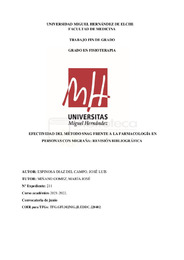Por favor, use este identificador para citar o enlazar este ítem:
https://hdl.handle.net/11000/28142Registro completo de metadatos
| Campo DC | Valor | Lengua/Idioma |
|---|---|---|
| dc.contributor.advisor | Miñano Gómez, María José | - |
| dc.contributor.author | Espinosa Díaz del Campo, José Luis | - |
| dc.contributor.other | Departamentos de la UMH::Patología y Cirugía | es_ES |
| dc.date.accessioned | 2022-10-31T10:09:45Z | - |
| dc.date.available | 2022-10-31T10:09:45Z | - |
| dc.date.created | 2022-06-20 | - |
| dc.identifier.uri | https://hdl.handle.net/11000/28142 | - |
| dc.description.abstract | Introducción: La migraña es uno de los grandes problemas de salud en nuestra sociedad debido a su elevada prevalencia y elevado nivel de discapacidad que provoca al paciente. Es una cefalea de origen neurológico. Existen diversas teorías sobre su etiología. Se cree que está causada por una hiperexcitabilidad dada en el sistema trigémino, lo que provoca un calor acumulado en las neuronas con una disminución de serotonina y un aumento de la inflamación dural. La técnica Snag de Mulligan puede ser un tratamiento adecuado más allá de los fármacos para mejorar la sintomatología. Objetivos: Conocer la efectividad de las técnicas cervicales de Mulligan (Snag) en pacientes con migraña en comparación del tratamiento farmacológico. Material y métodos: Se ha llevado a cabo una búsqueda bibliográfica a través de las principales bases de datos: PubMed, PEdro, Cochrane Library, ENFISPRO, Scopus y Embase publicados en los últimos 15 años. Se han seleccionado artículos que informasen de la migraña o disfunciones asociadas tratados mediante la técnica de Mulligan. Resultados: Observamos mejoras significativas en el dolor, la discapacidad producida por la migraña, el rango de movimiento y el umbral de punto de presión (PPT), Por otro lado el tratamiento farmacológico tuvo una alta tasa de éxito en la migraña. Conclusiones: Es posible de que a pesar de que los fármacos sugieren unos resultados más efectivos, en el futuro sería interesante realizar un estudio en comparación directa con el snag para mayor exactitud. | es_ES |
| dc.description.abstract | Introduction: Migraine is one of the great health problems in our society due to its high prevalence and high level of disability that can cause problems in the patient. It is a primary headache of neurological origin. There are various theories about its etiology. It is believed to be caused by hyperexcitability in the trigeminal system, causing heat buildup in neurons with decreased serotonin and increased dural inflammation. Mulligan's Snag technique may be an appropriate treatment beyond drugs to improve symptoms. Objectives: To know the effectiveness of Mulligan's cervical techniques (Snag) in patients with migraine in comparison to pharmacological treatment. Material and methods: A bibliographic search has been carried out through the main databases: PubMed, PEdro, Cochrane Library, ENFISPRO, Scopus and Embase published in the last 15 years. Articles reporting migraine or associated dysfunctions treated using the Mulligan technique have been selected. Results: Significant improvements in pain, migraine disability, range of motion, and pressure point threshold (PPT) are observed. On the other hand, pharmacological treatment had a high success rate in migraine. Conclusions: It is possible that despite the fact that the drugs suggest more effective results, in the future it would be interesting to carry out a study in direct comparison with snag and thus be able to be more exhaustive in the analysis. | es_ES |
| dc.format | application/pdf | es_ES |
| dc.format.extent | 34 | es_ES |
| dc.language.iso | spa | es_ES |
| dc.publisher | Universidad Miguel Hernández | es_ES |
| dc.rights | info:eu-repo/semantics/openAccess | es_ES |
| dc.rights | Attribution-NonCommercial-NoDerivatives 4.0 Internacional | * |
| dc.rights.uri | http://creativecommons.org/licenses/by-nc-nd/4.0/ | * |
| dc.subject | MULLIGAN | es_ES |
| dc.subject | SNAG | es_ES |
| dc.subject | Manipulaciones musculoesqueléticas | es_ES |
| dc.subject | Trastorno de migraña | es_ES |
| dc.subject.other | CDU::6 - Ciencias aplicadas | es_ES |
| dc.title | Efectividad del método SNAG frente a la farmacología en personas con migraña. Revisión bibliográfica | es_ES |
| dc.type | info:eu-repo/semantics/bachelorThesis | es_ES |

Ver/Abrir:
TFG. JOSÉ LUIS ESPINOSA DÍAZ DEL CAMPO..pdf
1,26 MB
Adobe PDF
Compartir:
 La licencia se describe como: Atribución-NonComercial-NoDerivada 4.0 Internacional.
La licencia se describe como: Atribución-NonComercial-NoDerivada 4.0 Internacional.
.png)